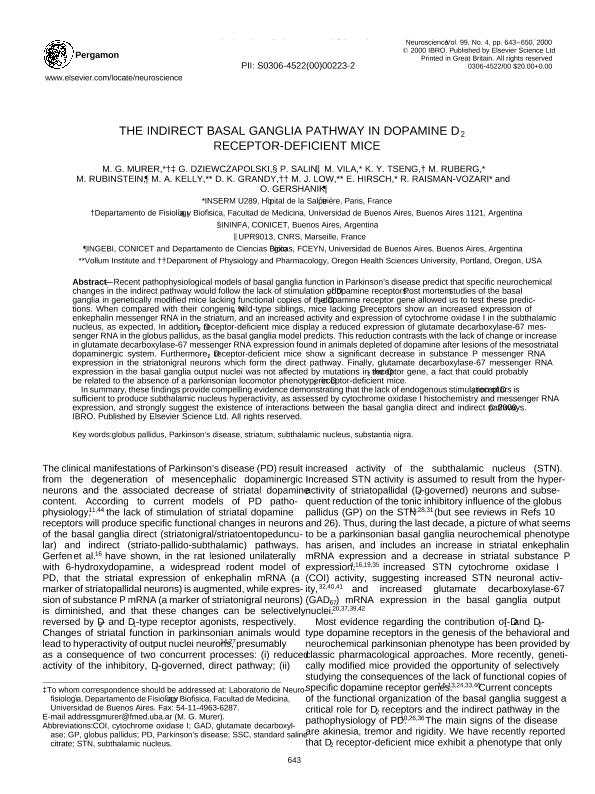Artículo
The indirect basal ganglia pathway in dopamine D2 receptor-deficient mice
Murer, Mario Gustavo ; Dziewczapolski, G.; Salin, P.; Vila, M.; Tseng, Kuei y; Ruberg, M.; Rubinstein, Marcelo
; Dziewczapolski, G.; Salin, P.; Vila, M.; Tseng, Kuei y; Ruberg, M.; Rubinstein, Marcelo ; Kelly, M. A.; Grandy, D. K.; Low, Malcolm J.; Hirsch, E.; Raisman Vozari, Rita; Gershanik, Oscar Samuel
; Kelly, M. A.; Grandy, D. K.; Low, Malcolm J.; Hirsch, E.; Raisman Vozari, Rita; Gershanik, Oscar Samuel
 ; Dziewczapolski, G.; Salin, P.; Vila, M.; Tseng, Kuei y; Ruberg, M.; Rubinstein, Marcelo
; Dziewczapolski, G.; Salin, P.; Vila, M.; Tseng, Kuei y; Ruberg, M.; Rubinstein, Marcelo ; Kelly, M. A.; Grandy, D. K.; Low, Malcolm J.; Hirsch, E.; Raisman Vozari, Rita; Gershanik, Oscar Samuel
; Kelly, M. A.; Grandy, D. K.; Low, Malcolm J.; Hirsch, E.; Raisman Vozari, Rita; Gershanik, Oscar Samuel
Fecha de publicación:
08/2000
Editorial:
Pergamon-Elsevier Science Ltd
Revista:
Neuroscience
ISSN:
0306-4522
Idioma:
Inglés
Tipo de recurso:
Artículo publicado
Clasificación temática:
Resumen
Recent pathophysiological models of basal ganglia function in Parkinson's disease predict that specific neurochemical changes in the indirect pathway would follow the lack of stimulation of D2 dopamine receptors. Post mortem studies of the basal ganglia in genetically modified mice lacking functional copies of the D2 dopamine receptor gene allowed us to test these predictions. When compared with their congenic N5 wild-type siblings, mice lacking D2 receptors show an increased expression of enkephalin messenger RNA in the striatum, and an increased activity and expression of cytochrome oxidase I in the subthalamic nucleus, as expected. In addition, D2 receptor-deficient mice display a reduced expression of glutamate decarboxylase-67 messenger RNA in the globus pallidus, as the basal ganglia model predicts. This reduction contrasts with the lack of change or increase in glutamate decarboxylase-67 messenger RNA expression found in animals depleted of dopamine after lesions of the mesostriatal dopaminergic system. Furthermore, D2 receptor-deficient mice show a significant decrease in substance P messenger RNA expression in the striatonigral neurons which form the direct pathway. Finally, glutamate decarboxylase-67 messenger RNA expression in the basal ganglia output nuclei was not affected by mutations in the D2 receptor gene, a fact that could probably be related to the absence of a parkinsonian locomotor phenotype in D2 receptor-deficient mice. In summary, these findings provide compelling evidence demonstrating that the lack of endogenous stimulation of D2 receptors is sufficient to produce subthalamic nucleus hyperactivity, as assessed by cytochrome oxidase I histochemistry and messenger RNA expression, and strongly suggest the existence of interactions between the basal ganglia direct and indirect pathways. (C) 2000 IBRO.
Archivos asociados
Licencia
Identificadores
Colecciones
Articulos(INGEBI)
Articulos de INST.DE INVEST.EN ING.GENETICA Y BIOL.MOLECULAR "DR. HECTOR N TORRES"
Articulos de INST.DE INVEST.EN ING.GENETICA Y BIOL.MOLECULAR "DR. HECTOR N TORRES"
Articulos(OCA HOUSSAY)
Articulos de OFICINA DE COORDINACION ADMINISTRATIVA HOUSSAY
Articulos de OFICINA DE COORDINACION ADMINISTRATIVA HOUSSAY
Citación
Murer, Mario Gustavo; Dziewczapolski, G.; Salin, P.; Vila, M.; Tseng, Kuei y; et al.; The indirect basal ganglia pathway in dopamine D2 receptor-deficient mice; Pergamon-Elsevier Science Ltd; Neuroscience; 99; 4; 8-2000; 643-650
Compartir
Altmétricas



